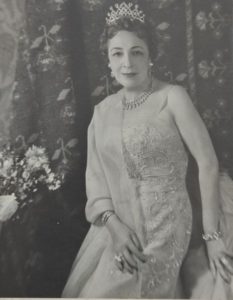“She was a large landowner of the sugar in Cuba and had to flee to Miami when the revolution”, account who was his couturier parisien Hubert de Givenchy: “always came to the Studio with two maids who brought something super-heavy-filled plastic bags on each arm and wondering what the hell would be there.” One day we learned that they were kilos and kilos of sapphires, rubies, emeralds and diamonds. The Lady went with her jewels everywhere because she was afraid of that robbed them!” ends up saying in his memories of his relations with the Havana Countess.
According to the casts of nobility, the title (she had been widowed Countess and childless) passed in 1953 to a nephew of her husband.
To the abandon definitely it Havana, left a nephew to charge of his mansion and, when also his nephew is marched, the House was intervened by the new regime and open to the public as Museum in 1964. Gathered there the collection of the Countess and the collection of Oscar B. tapes.
In 1961 (other sources give 1963 as date) were discovered behind a wall fake jewelry and silverware fine.
And still in 2003, the walls of the mansion were able of offer surprises: some panels of velvet needy of restoration and retired left see five pictures of the century 18th French that masking.
It was an unusual discovery. Is tried of five canvases of the century XVIII of the romanticism French, discovered in the current Museum of Arts decorative, of the street 17 and E, in the Vedado. Are paintings of theme bucolic, rural, with which decorated the main halls of the old palace of Maria Luisa Gomez-mena, Countess of Revilla of Camargo, that had abandoned the country.
Before convert is in Museum, the 24 of July of 1964, in a wall walled in the basement were found valuable works of art decorative, until the discovery occurred in the year 2OO3, before this valuable find, in them lounges only is could appreciate five immense velvets Golden, but these cloths is were something damaged, and its restoration required of a work full.
Soon tore cloths starting to remove them, time in which restoration experts were surprised with the discovery. Four canvases reach a meter and sixty centimeters in width, while the fifth will reach two meters twenty centimeters. More than 40 years masked and were in perfect condition.
As a made curious highlight that between them visitors distinguished of the Countess were them Dukes of Windsor, Member of the family real British, who would reign as Eduardo Xlll starting from 1934, of not have waived to the throne by love. A passionate affair with the commoner Wallis Warfield, a divorced American woman’s maiden name. Lady Windsor, since then.
In them photos that them illustrious visitors is took during their visit to the Countess, back appear them pictures disappeared and appeared subsequently, and that today you can contemplate, between other jewelry of the art universal, in the Museum of art decorative, with their 40 doors and eleven salons.
Agencies / Excerpts / Various / Juan B. Rodríguez / Internet Photos / Arnoldo Varona / TheCubanHistory.com
THE CUBAN HISTORY, HOLLYWOOD.
LA HABANA, CUBA: LOS SECRETOS DE LA CONDESA DE REVILLA DE CAMARGO.
“Había sido una gran terrateniente del azúcar en Cuba y había tenido que huir a Miami cuando la Revolución”, cuenta el que fuera su modisto parisien Hubert de Givenchy: “Siempre venía al atelier con dos mucamas que traían bolsas de plástico llenas de algo pesadísimo en cada brazo y nos preguntábamos qué demonios llevarían ahí. Un día nos enteramos que eran kilos y kilos de zafiros, rubíes, esmeraldas y diamantes. ¡La señora iba con sus joyas a todas partes porque tenía miedo de que se las robasen!” termina diciendo en los recuerdos de sus relaciones con la condesa habanera.
Según los elencos de nobleza, el título (ella había sido condesa viuda y sin hijos) pasó en 1953 a un sobrino de su esposo.
Al abandonar definitivamente La Habana, dejó un sobrino a cargo de su mansión y, cuando también su sobrino se marchó, la casa fue intervenida por el nuevo régimen y abierta al público como museo en 1964. Juntaron allí la colección de la condesa y la colección de Oscar B. Cintas.
En 1961 (otras fuentes dan 1963 como fecha) fueron descubiertas detrás de una pared falsa joyas y platería fina.
Y todavía en 2003, las paredes de la mansión resultaban capaces de ofrecer sorpresas: unos paneles de terciopelo necesitados de restauración y retirados dejaron ver cinco cuadros del siglo XVIII francés que enmascaraban.
Fue un descubrimiento insólito. Se trató de cinco lienzos del siglo XVIII del romanticismo francés, descubiertos en el actual Museo de Artes Decorativas, de la calle 17 y E, en el Vedado. Son pinturas de tema bucólico, rurales, con los cuales decoró los principales salones del antiguo palacete de María Luisa Gómez-Mena, Condesa de Revilla de Camargo, que había abandonado el país.
Antes de convertirse en Museo, el 24 de julio de 1964, en una pared tapiada en el sótano fueron encontrados valiosas obras de arte decorativas, hasta el descubrimiento ocurrido en el año 2OO3, antes de este valioso hallazgo, en los salones solo se podían apreciar cinco inmensos terciopelos dorados, pero estos paños se encontraban algo deteriorados, y su restauración requería de un trabajo completo.
Pronto se rasgaron los paños al empezar a quitarlos, momento en que los peritos de restauración quedaron sorprendidos con el hallazgo. Cuatro lienzos alcanzan un metro y sesenta centímetros de ancho, mientras que el quinto llega a dos metros veinte centímetros. Más de 40 años enmascarados y se encontraron en perfecto estado.
Como un hecho curioso destacamos que entre los visitantes distinguidos de la Condesa estuvieron los duques de Windsor, miembro de la familia real británica, quien hubiera reinado como Eduardo Xlll a partir de 1934, de no haber renunciado al trono por amor. Un apasionado romance con la plebeya Wallis Warfield, nombre de soltera de una mujer divorciada, norteamericana. Lady Windson, desde entonces.
En las fotos que los ilustres visitantes se tomaron durante su visita a la Condesa, detrás aparecen los cuadros desaparecidos y aparecidos posteriormente, y que hoy usted puede contemplar, entre otras joyas del arte universal, en el Museo de Arte Decorativas, con sus 40 puertas y once salones.
Agencies/Excerpts/Various/Juan B. Rodriguez/Internet Photos/ Arnoldo Varona/ TheCubanHistory.com
THE CUBAN HISTORY, HOLLYWOOD.









